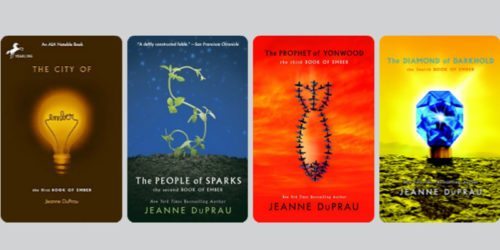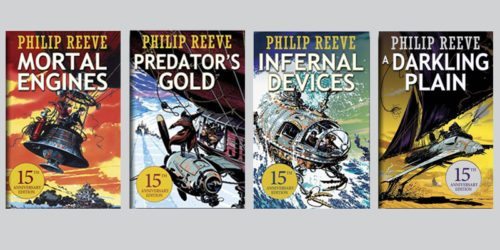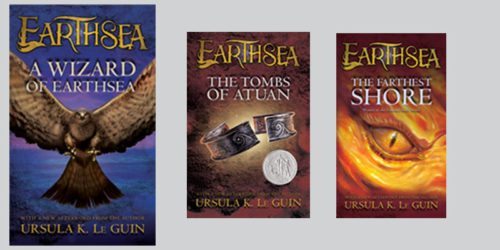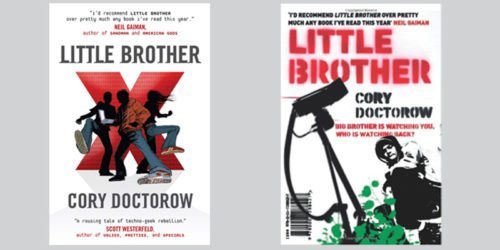
I vividly remember watching the first Ice Age movie with much glee, on a Sunday morning surrounded by children of all sizes, shapes and ages. While everyone in the theatre enjoyed the overt comedy of that motley crew and their misadventures, the people who looked like they were enjoying the most were the older children – the ones with jobs, spouses, and EMIs.
Because apart from the funny adventures, it was mostly the older children who got the puns (taekwon-dodo!) and laughed at the absurdity inherent in preparing for an ice age with three watermelons.
The same is the case with many books: they can be enjoyed by children of all ages, with good ol’ fashioned adventures and a whole lot of ideas, told in a simple manner. And this is the first criteria guiding this list of science fiction & fantasy (SFF) books, which you can read below, once I’m done with all the background gyaan, brought on in no small way by the fact that the shortlist itself was too long.
Because apart from the funny adventures, it was mostly the older children who got the puns and laughed at the absurdity inherent in preparing for an ice age with three watermelons.
So there went the comics, a couple of series that contained more than four books (sorry Temeraire), stories that haven’t held up well over the course of time (apologies to Paul French/Isaac Asimov and the Lucky Starr series). They are gone from today’s list, but not forgotten – merely biding their time for another day, another edition, including those that deserve a full piece of their own, like Philip Pullman’s His Dark Materials trilogy, Terry Pratchett’s Nome trilogy, and the Heinlein ‘juveniles’.
There were many that didn’t make it to the shortlist even, but only because they are already very popular and don’t need another list to recommend them (the Harry Potter series & Hunger Games trilogy) or classics by Jules Verne and HG Wells, which I think every child ought to read. Last but not the least, these were all books written for children (the younger ones), and at the very least feature children as protagonists. The word bildungsroman springs to mind, which is a fancy way of saying coming-of-age story.
On with today’s list then? In no particular order, except for a nebulous ascending order from younger to older. Get ready for predatory cities, shadowy garbage bins, magic, spaceships, time travel, wizards and scientists, hackers and everything in between.
City of Ember – Jeanne DuPrau

A post-apocalyptic scenario has never been this much fun or adventure filled. The titular city was established 200 years ago, deep underground with supplies to last that period — but don’t tell the children of Ember that, because they belong to a generation for whom that is a mythical past. There are instructions from the original ‘builders’ of Ember with instructions on what to do when the right time comes. But these instructions are thought to be lost, and Ember has gone beyond the 200-year limit. The protagonist, young Lina Mayfleet, may have stumbled upon the instructions just as the lights are starting to go out in Ember, with its infrastructure fraying and crumbling. Follow Lina and her friend Doon Harrow as they embark on an adventure, stumbling from one piece of the city’s past to another till they learn the surprising truth about their beloved city. Winner of multiple awards and praised for its very human handling of the story, Children of Ember is the first book in a quartet that includes two sequels, The People of Sparks and The Diamond of Darkhold, and a prequel, The Prophet of Yonwood.
The lead image shows Luna & Doon in a scene from the movie based on the first book, City of Ember.
Mortal Engines – Philip Reeve

A post-apocalyptic scenario has never this much fun or adventure filled. Ok, I said that for the quartet above too, but it’s true for this one too. Mortal Engines is the first of a steampunk-meets-post-apocalyptic-fiction tetralogy – along with Predator’s Gold, Infernal Devices and A Darkling Plain – that is collectively called the Predator Cities series (and also the Hungry City Chronicles) for a reason. The ‘cities’ in this book are predators, preying upon other ‘cities’, hungry as they are to evolve and upgrade their city’s tech. Ok then, from the top. Mortal Engines introduces us to a future earth that had previously been devastated by a war, and is now in a Traction Era — so called because all the big cities are mobile (with wheels and moving on caterpillar tracks), devouring smaller cities and ‘digesting’ them for their tech, in a technological ecosystem called ‘Municipal Darwinism’. Opposing these cities is the Anti-Traction League. Getting caught up in all this is our lead protagonist, Tom Natsworthy, a 15-year-old orphan and apprentice Historian at the beginning, who grows up over the course of the series, finds love, adventure, makes friends and enemies, indulges in intrigue involving airships, rebels and bombs, marries, has a precocious child of his own, while dealing with a changing world and yes, even a sentient AI. Peter Jackson is making a movie on this, so apart from all that I mentioned above, this should give you another reason to pick this up before the movie comes out in a couple of years.
A Wizard of Earthsea – Ursula K. Le Guin

From the grand dame of SFF, the author who The New York Times described as ‘America’s greatest living science fiction writer’, comes this timeless classic of magic, adventure, darkness, dragons, wizards, witches, wonder and wisdom. A Wizard of Earthsea introduces us to the titular archipelago of Earthsea and the titular wizard, Ged (use-name Sparrowhawk), a young dragonlord who is sent to the island of Roke to learn the true way of magic, in a time when magic is giving way to evil. From here on, we follow the hero’s journey over the course of a quintet, with The Tombs of Atuan, The Farthest Shore, Tehanu and The Other Wind that chart all his reckless mistakes, his triumphs and tribulations, as he goes from student to mage to arch-mage to ex-arch-mage to farmer and back to mage. All these five books, along with a sixth, Tales from Earthsea (a collection of non-Ged short stories set in Earthsea) form what is known as the Earthsea cycle. A must-read for anyone interested in good literature and definitely for anyone who loves a magical read with fantastic yet somehow realistic world-building and a truly fully-formed system of magic and culture. It is for very good reasons that acclaimed author Margaret Atwood called it ‘one of the wellsprings of modern fantasy literature.’
And now for the standalone books.
Don’t go by the multiple covers, they’re just different editions of the same book.
Un Lun Dun – China Miéville

If you have to read one book where the villain is an evil, sentient cloud of pollution, let this be it (I honestly can’t think of another). And yes, the author’s name is China and he just happens to be one of the biggest names in contemporary SFF with quite a few big awards sitting on his shelf. So, welcome to the unWorld of an abcity: an under-cities that mirror the cities we know and live in. Abcities are where things abandoned as unwanted or obsolete or just simply lost by the city dwellers seep down to, and every major city has its own abcity; New York has No York, Los Angeles has Lost Angeles, and there are Parisn’t, Helsunki and Hong Gone to name a few. The setting for this book is the abcity of UnLondon, and tells the story of two friends, Susanna Moon aka Zanna and Deeba Rehman, who find themselves in the strange world of UnLondon. Zanna just happens to find out she’s the the Chosen One, the one prophesied to defeat Smog, the evil sentient cloud of pollution, who is wreaking havoc on UnLondon. Filled with twists, puns, clever wordplay and featuring a cast of characters that includes Curdle, the brave little milk carton, binjas (living ninja garbage bins), bloodthirsty giraffes and an UnChosen One, with illustrations from the author himself, Un Lun Dun is truly a read for all ages.
Neil Gaiman – The Graveyard Book

This book is about Nobody. Full name: Nobody Owens. Nickname: Bod. Family: Murdered while still a toddler, and currently the only surviving member. And that’s because he toddled – as toddlers do – towards the nearest graveyard (thus escaping being murdered himself) and got accepted by the supernatural beings whose residence the graveyard was, with real ghosts for foster parents. Neil Gaiman, after seeing his own young son comfortable around a graveyard, wondered what it’d be like to write a story like Rudyard Kipling’s Jungle Book but set in a graveyard, and thus The Graveyard Book was born. The Sher Khan of this story is the man Jack, the murderer; looking out for Bod is Silas, an ex-evil vampire. Over the course of the book, Bod has many adventures (of course!), learns a lot of supernatural abilities from his adoptive parents and a vampire, and makes friends with Scarlett Perkins, who is convinced that Bod’s her imaginary friend. And during all this time, the man Jack is still out there looking to kill Bod (there are ancient, secret societies involved). Written in Gaiman’s to-be-expected delightful (magical?) prose, but for children and with illustrations by Chris Riddell, The Graveyard Book is also available as an awesome comic book for those who prefer the medium. Gaiman fans have an additional treat waiting for them if they didn’t already know, that there’s an audiobook version too, narrated by none other than Gaiman himself. Gaiman, by the way, highly recommends the next – and last – book on today’s list.
Cory Doctorow – Little Brother

You’ve read about Big Brother, it’s time now to read Little Brother, a novel about people like you and me – ok, actually teenagers – fighting the system, and fighting it well. With the weapon of choice being that ubiquitous thing we call technology. By far the most subversive (and ‘adult’) book on this list, this multiple-award winning novel by journalist and co-editor of the popular blog Boing Boing, Cory Doctorow, Little Brother introduces us to an unlikely hero, w1n5t0n aka Marcus Yallow, a tech-whiz who’s a regular though rebellious teenager who loves hacking and playing games with his friends. Till one day there’s a terrorist attack and Marcus and his friends gets taken in for some hard questioning (read interrogation in a secret prison) by the Department of Homeland Security. Obviously they’re innocent, but the DHS doesn’t think so. So begins a fight against the DHS with private networks, arphids, jamming and a whole of hacking goin’ on. There are twists and turns, and the pages turn by themselves till the end of the story, which is ultimately about personal liberty, free speech, about freedom itself. Bonus: Afterwords from a security technologist (go hack a security system!) and a researcher-cum-hacker, plus a bibliography that contains everything from Jack Kerouac and NWW-regular Neal Stephenson to applied cryptography and the Pirate Party. Bigger Bonus: Little Brother is one book on this list you needn’t buy, because, as a proponent of liberal copyright laws and of Creative Commons, Doctorow has made this book available to everyone to download for free online on his site.
So there you go dear reader, gift your son/daughter/nephew/niece any of the above (or all), and introduce them to new worlds of wonder and come across as a great father/father/uncle/aunt and when they’re done with it, quietly borrow and read it yourself. Or the other way round. Also recommended for those who want to buy it solely for themselves, for the children that they still are.
And on that note, I bid you farewell until next week, when I hope to see you back here again for another edition of New Worlds Weekly. Live long and prosper, and have a very merry Christmas.
PS: Given how many books have been left out of this list – it was a difficult choice to leave out some much-loved books – I request you to consider this the first instalment of many, for there will be more. And that’s a promise, not a threat!
Subscribe to FactorDaily
Our daily brief keeps thousands of readers ahead of the curve. More signals, less noise.
To get more stories like this on email, click here and subscribe to our daily brief.
Disclosure: FactorDaily is owned by SourceCode Media, which counts Accel Partners, Blume Ventures and Vijay Shekhar Sharma among its investors. Accel Partners is an early investor in Flipkart. Vijay Shekhar Sharma is the founder of Paytm. None of FactorDaily’s investors have any influence on its reporting about India’s technology and startup ecosystem.








